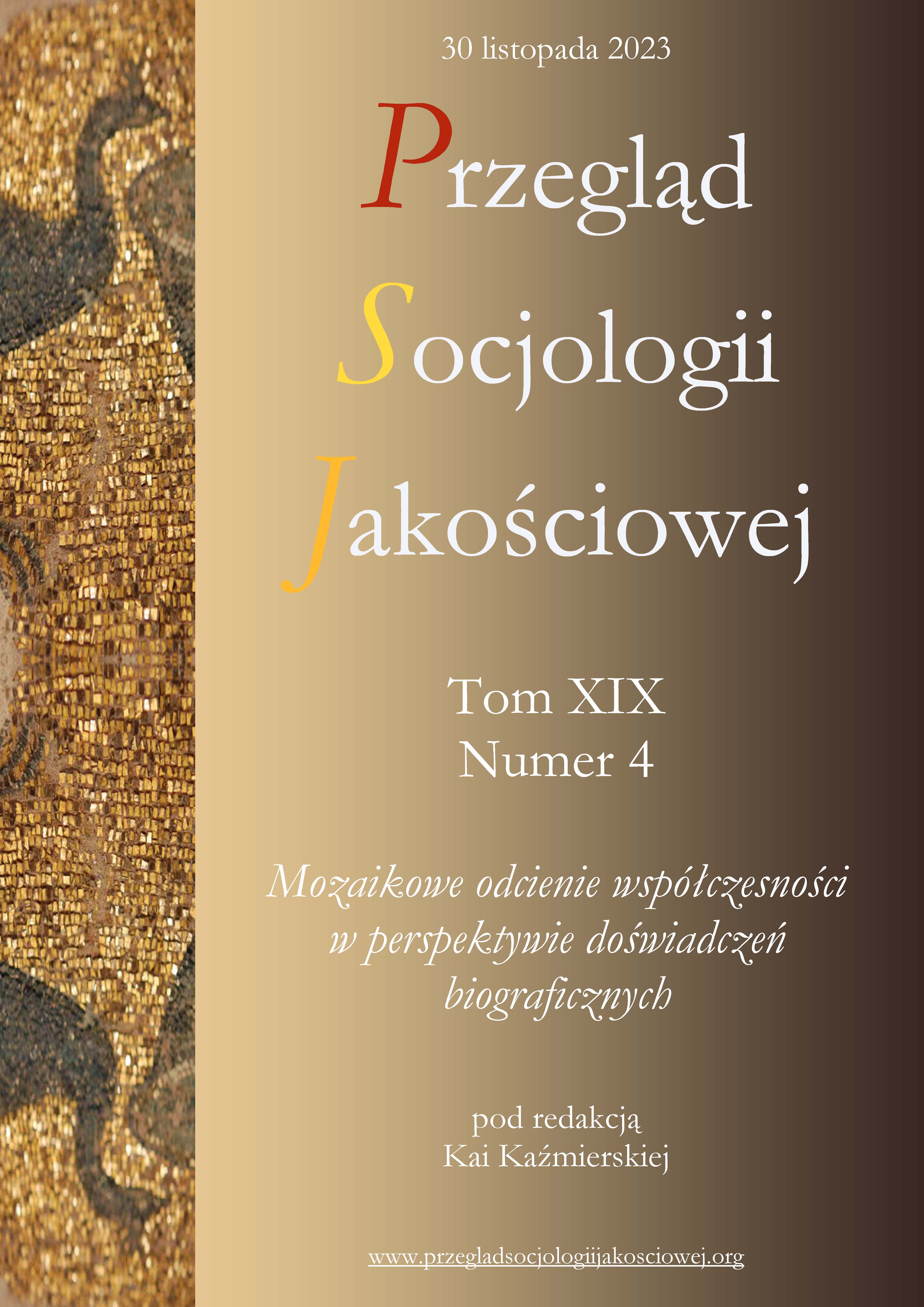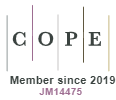Spacerowanie po mieście
DOI:
https://doi.org/10.18778/1733-8069.19.4.08Słowa kluczowe:
badania kontemplacyjne, chodzenie po mieście, ciało, emocje, autoobserwacje, socjologia ciała, socjologia emocjiAbstrakt
Artykuł jest kontemplacyjną eksplikacją procesu spacerowania. Jakie są istotne cechy spacerowania i w jaki sposób osoby spacerujące po mieście tego doświadczają? W opracowaniu wykorzystano kontemplacyjne metody badawcze i dokonano eksplikacji fenomenu chodzenia. Badania opierają się na autooobserwacjach i autoopisach myśli, odczuć ciała i emocji, które pojawiały się podczas spacerów u uczestników projektu badawczego.
W artykule opisano cechy zjawiska spacerowania. Najpierw przeanalizowano proces myślenia generowany przez chodzenie po mieście. Następnie omówiono patyczny (ang. pathic) wymiar chodzenia (zwłaszcza nastrój), odczucia cielesne, doświadczanie relacji z innymi oraz refleksje nad życiem i sobą, które są konsekwencją chodzenia/spacerowania.
Pobrania
Bibliografia
Azizi Maryam (2021), Does Walking Help with Mental Health Problems?, https://www.news-medical.net/health/Does-Walking-Aid-Mental-Health-Problems.aspx (accessed: 5.09.2023).
Google Scholar
Baudelaire Charles (1964), The Painter of Modern Life, [in:] The Painter of Modern Life and Other Essays, edited and translated by Jonathan Mayne, London: Phaidon Press, s. 1–33.
Google Scholar
Bauman Zygmunt (1994), Desert spectacular, [in:] K. Tester (ed.), The flaneur, London–New York: Routledge, pp. 138–157.
Google Scholar
DOI: https://doi.org/10.4324/9780203420713_chapter_7
Benjamin Walter (1997), Charles Baudelaire: a lyric poet in the era of high capitalism, London–New York: Verso.
Google Scholar
Bentz Valerie M., Giorgino Vincenzo (2016), Contemplative Social Research. Caring for Self, Being and Lifeworld, Santa Barbara: Fielding University Press.
Google Scholar
Bentz Valerie M., Shapiro Jeremy J. (1998), Mindful inquiry in social research, Thousand Oaks: SAGE Publications.
Google Scholar
DOI: https://doi.org/10.4135/9781452243412
Blumer Herbert (1969), Symbolic Interactionism. Perspective and Method, Berkley: University of California Press.
Google Scholar
Byung-Chul Han (2022), Społeczeństwo zmęczenia i inne eseje, Warszawa: Wydawnictwo Krytyki Politycznej.
Google Scholar
Caparrós Martin (2020), Hunger, Brooklyn–London: Melville House.
Google Scholar
Certeau Michel de (1984), The Practice of Everyday Life, Berkeley: University of California Press.
Google Scholar
Clark Candance (2002), Taming the „Brute Being”: Sociology Reckons with Emotionality, [in:] Joseph A. Kotarba, John M. Johnson (eds.), Postmodern Existential Sociology, Walnut Creek: Altamira Press, pp. 155–182.
Google Scholar
Cochrane Joe (2017), Jakarta, the City Where Nobody Wants to Walk, “New York Times”, August 20, 2017, https://www.nytimes.com/2017/08/20/world/asia/jakarta-walking-study-sidewalks.html (accessed: 5.09.2023).
Google Scholar
Coverley Merlin (2012), The Art of Wandering: The Writer as Walker, London: Oldcastle Books.
Google Scholar
DeSilva Jeremy (2022), Fossils Upend Conventional Wisdom about Evolution of Human Bipedalism, “Scientific American”, November 1, 2022, https://www.scientificamerican.com/article/fossils-upend-conventional-wisdom-about-evolution-of-human-bipedalism/ (accessed: 22.09.2023).
Google Scholar
Gallagher Shaun (2005), How the body shapes the mind, Oxford: Oxford University Press.
Google Scholar
DOI: https://doi.org/10.1093/0199271941.001.0001
Gibson James J. (2015), The Ecological Approach to Visual Perception, Classical Edition, New York: Psychology Press.
Google Scholar
DOI: https://doi.org/10.4324/9781315740218
Goffman Erving (1967), Interaction Ritual. Essays on Face to Face Behavior, New York: Anchor Books.
Google Scholar
Gros Frédéric (2021), Marcher, une Philosophie, Paris: Editions Albin Michel.
Google Scholar
Hall Tom (2009), Footwork: moving and knowing in local space(s), “Qualitative Research”, vol. 9(5), pp. 571–585, https://doi.org/10.1177/1468794109343626
Google Scholar
DOI: https://doi.org/10.1177/1468794109343626
Kaag John (2018), Hiking with Nietzsche. On Becoming Who You Are, New York: Farrar, Strauss, Giroux.
Google Scholar
Kaczyński: palić „wszystkim poza oponami i podobnymi rzeczami”. A co na to prawo? (2022), https://konkret24.tvn24.pl/polska/kaczynski-palic-wszystkim-poza-oponami-i-podobnymi-rzeczami-a-co-na-to-prawo-ra1117472-ls6113425 (accessed: 21.09.2023).
Google Scholar
Kočková Jana (2015), Walking in the city: A case study of the streets in Brno, “Human Affairs”, vol. 4(26), pp. 422–439.
Google Scholar
DOI: https://doi.org/10.1515/humaff-2016-0036
Konecki Krzysztof T. (2017), Standing in Public Places: An Ethno-Zenic Experiment Aimed at Developing the Sociological Imagination and More Besides…, “Czech Sociological Review”, vol. 53(6), pp. 881–901.
Google Scholar
DOI: https://doi.org/10.13060/00380288.2017.53.6.379
Konecki Krzysztof T. (2018), Advances in Contemplative Social Research, Łódź–Krakow: Lodz University Press, Jagiellonian University Press.
Google Scholar
Konecki Krzysztof T. (2022), The Meaning of Contemplation for Social Qualitative Research. Applications and Examples, London–New York: Routledge.
Google Scholar
DOI: https://doi.org/10.4324/9781003179689
Kotarba Joseph A., Johnson John M. (eds.) (2002), Postmodern Existential Sociology, Walnut Creek: Altamira Press.
Google Scholar
Lewis Dyani (2023), Short arms and lanky legs: the genetic basis of walking on two legs, “Nature”, July 20 2023, https://www.nature.com/articles/d41586-023-02345-7 (accessed: 21.09.2023)
Google Scholar
Lovejoy C. Owen (1988), Evolution of Human Walking, “Scientific American”, vol. 259(5), pp. 118–125, http://www.jstor.org/stable/24989268 (accessed: 21.09.2023).
Google Scholar
DOI: https://doi.org/10.1038/scientificamerican1188-118
Low Kelvin E.Y., Kalekin-Fishman Devorah (eds.) (2018), Senses in Cities. Experiences of Urban Settings, Abingdon: Routledge.
Google Scholar
DOI: https://doi.org/10.4324/9781315527376
Majer Andrzej (2015), Mikropolis. Socjologia miasta osobistego, Łódź: Wydawnictwo Uniwersytetu Łódzkiego.
Google Scholar
DOI: https://doi.org/10.18778/7969-856-1
Manen Max van (2014), The phenomenology of Practice. Meaning Giving Methods in Phenomenological Research and Writing, London–New York: Routledge.
Google Scholar
Manen Max van (2016), Researching Lived Experience. Human Science for an Action Sensitive Pedagogy, New York–London: Routledge.
Google Scholar
Merleau-Ponty Maurice (1962), Phenomenology of Perception, London: Routledge.
Google Scholar
Middleton Jennie (2011), Walking in the City: The Geographies of Everyday Pedestrian Practices, “Geography Compass”, no. 5, pp. 90–105, https://doi.org/10.1111/j.1749-8198.2010.00409.x
Google Scholar
DOI: https://doi.org/10.1111/j.1749-8198.2010.00409.x
Moore Robert (1995), Dereification in Zen Buddhism, “The Sociological Quarterly”, vol. 36(4), pp. 699–723.
Google Scholar
DOI: https://doi.org/10.1111/j.1533-8525.1995.tb00461.x
National Walking Month: how walking can boost your mental health (2023), https://www.healthassured.org/blog/national-walking-month/ (accessed: 6.09.2023).
Google Scholar
Nhat Hanh Thich (2021), Walking Meditation: Easy Steps to Mindfulness, Louisville: Sounds True Inc.
Google Scholar
Oblak Ales, Boyadzhieva Asena, Caporusso Jaya, Škodlar Borut, Bon Jurij (2022), How Things Take Up Space: A Grounded Theory of Presence and Lived Space, “The Qualitative Report”, vol. 27(11), pp. 2556–2582, https://doi.org/10.46743/2160-3715/2022.5762
Google Scholar
DOI: https://doi.org/10.46743/2160-3715/2022.5762
Paetzold Heinz (2013), The Aesthetics of City Strolling, “Contemporary Aesthetics”, vol. 11, https://quod.lib.umich.edu/c/ca/7523862.0011.023?view=text;rgn=main (accessed: 6.09.2023).
Google Scholar
Pink Sarah (2009), Doing Sensory Ethnography, London: SAGE.
Google Scholar
DOI: https://doi.org/10.4135/9781446249383
Rehorick David A., Bentz Valerie Malhotra (eds.) (2008), Transformative Phenomenology. Changing Ourselves, Lifeworlds, and Professional Practice, Lanham: Lexington Books.
Google Scholar
Reimann Maria (2019), Nie przywitam się z państwem na ulicy. Szkic o doświadczaniu niepełnosprawności, Wołowiec: Wydawnictwo Czarne.
Google Scholar
Rosa Hartmut (2020), Przyspieszenie, wyobcowanie, rezonans. Projekt krytycznej teorii późnonowoczesnej czasowości, Gdańsk: Europejskie Centrum Solidarności.
Google Scholar
Rosenbloom Stephanie (2023), The Art of Being a Flâneur, “New York Times”, June 19, 2023, https://www.nytimes.com/2023/06/19/travel/walking-travel-cities.html (accessed: 5.09.2023).
Google Scholar
Solnit Rebecca (2008), Zew włóczęgi. Opowieści wędrowne (Wanderlust), Kraków: Karakter.
Google Scholar
Svensson Marina (2021), Walking in the historic neighbourhoods of Beijing: walking as an embodied encounter with heritage and urban developments, “International Journal of Heritage Studies”, vol. 27(8), pp. 792–805, https://doi.org/10.1080/13527258.2020.1821240
Google Scholar
DOI: https://doi.org/10.1080/13527258.2020.1821240
Tanaka Shogo (2018), Bodily Basis of the Diverse Modes of the Self, “Human Arenas”, vol. 1, pp. 223–230, https://doi.org/10.1007/s42087-018-0030-x
Google Scholar
DOI: https://doi.org/10.1007/s42087-018-0030-x
Pobrania
Opublikowane
Wersje
- 2023-11-30 - (2)
- 2023-11-30 - (1)
Jak cytować
Numer
Dział
Licencja

Utwór dostępny jest na licencji Creative Commons Uznanie autorstwa – Użycie niekomercyjne – Bez utworów zależnych 4.0 Międzynarodowe.














